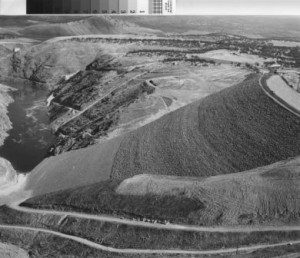
Stanislaus County agriculture comes alive in April with almost all perennial crops coming out of winter and spring dormancy. Grapes usually are one of the last to emerge with the green tissue you see bust out and grow with vigor. Soon you will see forage crops being harvested and you can tell by seeing big choppers blowing chopped material into a truck traveling along side. Most of this will be going to dairy animals for feed. This is the first sign of what will be a long harvest season with our 250 different crops grown in Stanislaus County through the end of November.
The almond crop at this point looks very strong. However with late spring rains, you might see growers out spraying their fields with fungicides to protect the almonds and the leaves from disease. A disease at this stage of growth may make the tree weak. A weakened tree may abort the nuts, leading to a much smaller crop set along with leaving the tree open to more problems for the following summer. This then makes the almond tree susceptible to other pests such as Spider Mites, Navel Orange Worm and Peach Twig Borer. These trees are made to produce nuts. A tree without nuts becomes nothing more than a large shade tree that still costs money to protect.
The walnut crop is still too early to see what it might bear at this point. You might see walnut growers doing the same as almond growers at this point fighting disease and pest problems. Peaches have bloomed with their pink blossoms and cherries will have their white blossoms. Cherries are one of the fastest growing fruit from bloom to harvest. Most of California will be harvesting in May. Cherry growers want a dry time leading up to harvest because rains during the growth stage lead to “split pits.” While the quality is still good, the cosmetic appearance is not how the consumer envisions a cherry. Therefore, buyers and exporters pay far less for a perfectly good piece of fruit.
Now for a little water talk. While many of our dams in the Sierra provide for irrigation, their greatest purpose is flood control. Imagine Modesto without Don Pedro Dam right now – parts would probably be under water! In late March, the inflow was nearly 28,000 CFS (cubic feet per second) – over four times greater than we currently see in the Tuolumne River under the Highway 99 bridge! All that snow and rain water must go somewhere and that somewhere is DOWN the river and out into the Delta and eventually under the Golden Gate. And that was just one day! Remember 1997 and the results of the “Pineapple Express?” And that was with Don Pedro Dam in place! With storm upon storm lashing the valley and mountains, this could be a continual problem that we don’t have to deal with thanks to the foresight of farmers at the beginning of the 20th Century!
When you think about it dams provide the public with a long list of advantages. During the winter months, Don Pedro provides flood protection to all of the people and homes along the Tuolumne River. Throughout the year, water from Don Pedro is put into the Modesto Reservoir where is it purified and sent to Modesto as drinking water. Tuolumne River water also nurtures and provides habitat for multiple species of fish, mammals and aquatic life throughout the river basin. When you turn your lights on, let’s not forget Don Pedro and the cheapest form of renewable energy available to the consumer – falling water – hydropower! And last but not least, all of the crops we talk about from month to month are irrigated from the canals that crisscross Stanislaus County. So, Don Pedro water also leads to food production that is grown locally and consumed around the world. Water leads to jobs and that multiplier effect that agriculture has on the community. $2.5 Billion in farm gate revenue leads to nearly $11 Billion in our local economy.
Thanks for reading and we look forward to next month! Remember to support your local farmers and the products grown here because farmers feed families! It really does make a difference in your daily life!
Stanislaus County Agriculture! See It! Feel It! Taste It!








